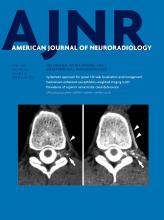Index by author
Zang, F.
- PediatricsOpen AccessMorphologic Evolution and Coordinated Development of the Fetal Lateral Ventricles in the Second and Third TrimestersZ. Li, F. Xu, Z. Zhang, X. Lin, G. Teng, F. Zang and S. LiuAmerican Journal of Neuroradiology April 2019, 40 (4) 718-725; DOI: https://doi.org/10.3174/ajnr.A6013
Zeng, J.Y.
- Adult BrainOpen AccessEffects of Acute Alcohol Consumption on the Human Brain: Diffusional Kurtosis Imaging and Arterial Spin-Labeling StudyL.M. Kong, J.Y. Zeng, W.B. Zheng, Z.W. Shen and R.H. WuAmerican Journal of Neuroradiology April 2019, 40 (4) 641-647; DOI: https://doi.org/10.3174/ajnr.A5992
Zhang, R.
- FELLOWS' JOURNAL CLUBNeurointerventionOpen AccessMetallic Hyperdensity Sign on Noncontrast CT Immediately after Mechanical Thrombectomy Predicts Parenchymal Hemorrhage in Patients with Acute Large-Artery OcclusionC. Xu, Y. Zhou, R. Zhang, Z. Chen, W. Zhong, X. Gong, X. Ding and M. LouAmerican Journal of Neuroradiology April 2019, 40 (4) 661-667; DOI: https://doi.org/10.3174/ajnr.A6008
The authors evaluated 198 consecutive patients with acute ischemic stroke with large-vessel occlusion who underwent noncontrast CT immediately after mechanical thrombectomy between January 2014 and September 2018. The metallic hyperdensity sign was defined as a nonpetechial intracerebral hyperdense lesion in the basal ganglia and a maximum CT density of >90 HU. The metallic hyperdensity sign was found in 59 (29.7%) patients, and 51 (25.7%) patients had parenchymal hemorrhage at 24 hours. Patients with the metallic hyperdensity sign are more likely to have parenchymal hemorrhage than those without it.
Zhang, Z.
- PediatricsOpen AccessMorphologic Evolution and Coordinated Development of the Fetal Lateral Ventricles in the Second and Third TrimestersZ. Li, F. Xu, Z. Zhang, X. Lin, G. Teng, F. Zang and S. LiuAmerican Journal of Neuroradiology April 2019, 40 (4) 718-725; DOI: https://doi.org/10.3174/ajnr.A6013
Zhao, L.B.
- Adult BrainOpen AccessRisk of Acute Kidney Injury with Consecutive, Multidose Use of Iodinated Contrast in Patients with Acute Ischemic StrokeZ.Y. Jia, S.X. Wang, L.B. Zhao, Y.Z. Cao, H.B. Shi and S. LiuAmerican Journal of Neuroradiology April 2019, 40 (4) 652-654; DOI: https://doi.org/10.3174/ajnr.A5959
Zheng, W.B.
- Adult BrainOpen AccessEffects of Acute Alcohol Consumption on the Human Brain: Diffusional Kurtosis Imaging and Arterial Spin-Labeling StudyL.M. Kong, J.Y. Zeng, W.B. Zheng, Z.W. Shen and R.H. WuAmerican Journal of Neuroradiology April 2019, 40 (4) 641-647; DOI: https://doi.org/10.3174/ajnr.A5992
Zhong, W.
- FELLOWS' JOURNAL CLUBNeurointerventionOpen AccessMetallic Hyperdensity Sign on Noncontrast CT Immediately after Mechanical Thrombectomy Predicts Parenchymal Hemorrhage in Patients with Acute Large-Artery OcclusionC. Xu, Y. Zhou, R. Zhang, Z. Chen, W. Zhong, X. Gong, X. Ding and M. LouAmerican Journal of Neuroradiology April 2019, 40 (4) 661-667; DOI: https://doi.org/10.3174/ajnr.A6008
The authors evaluated 198 consecutive patients with acute ischemic stroke with large-vessel occlusion who underwent noncontrast CT immediately after mechanical thrombectomy between January 2014 and September 2018. The metallic hyperdensity sign was defined as a nonpetechial intracerebral hyperdense lesion in the basal ganglia and a maximum CT density of >90 HU. The metallic hyperdensity sign was found in 59 (29.7%) patients, and 51 (25.7%) patients had parenchymal hemorrhage at 24 hours. Patients with the metallic hyperdensity sign are more likely to have parenchymal hemorrhage than those without it.
Zhou, X.
- FELLOWS' JOURNAL CLUBAdult BrainYou have accessMeasuring Glymphatic Flow in Man Using Quantitative Contrast-Enhanced MRIR. Watts, J.M. Steinklein, L. Waldman, X. Zhou and C.G. FilippiAmerican Journal of Neuroradiology April 2019, 40 (4) 648-651; DOI: https://doi.org/10.3174/ajnr.A5931
In this technical report, the authors used MR myelography to demonstrate the feasibility of T1 mapping to quantify contrast concentration to analyze glymphatic flow in man. There is increasing interest in its use as a biomarker and potential therapeutic target in Alzheimer disease.
Zhou, Y.
- EDITOR'S CHOICEAdult BrainOpen AccessMoving Toward a Consensus DSC-MRI Protocol: Validation of a Low–Flip Angle Single-Dose Option as a Reference Standard for Brain TumorsK.M. Schmainda, M.A. Prah, L.S. Hu, C.C. Quarles, N. Semmineh, S.D. Rand, J.M. Connelly, B. Anderies, Y. Zhou, Y. Liu, B. Logan, A. Stokes, G. Baird and J.L. BoxermanAmerican Journal of Neuroradiology April 2019, 40 (4) 626-633; DOI: https://doi.org/10.3174/ajnr.A6015
DSC-MR imaging using preload, intermediate (60°) flip angle and postprocessing leakage correction has gained traction as a standard methodology. Simulations suggest that DSC-MR imaging with flip angle = 30° and no preload yields relative CBV practically equivalent to the reference standard. Eighty-four patients with brain lesions were enrolled in this 3-institution study. Forty-three patients satisfied the inclusion criteria. DSC-MR imaging (3T, single-dose gadobutrol, gradient recalled-echo–EPI, TE=20–35 ms, TR=1.2–1.63 seconds) was performed twice for each patient, with flip angle = 30°–35° and no preload (P-) or provided preload (P+) for an intermediate flipangle = 60°. Compared with 60°/P+/C+, 30°/P-/C+ had closest mean standardized relative CBV, highest Lin concordance correlation coefficient, and lowest Bland-Altman bias.
- FELLOWS' JOURNAL CLUBNeurointerventionOpen AccessMetallic Hyperdensity Sign on Noncontrast CT Immediately after Mechanical Thrombectomy Predicts Parenchymal Hemorrhage in Patients with Acute Large-Artery OcclusionC. Xu, Y. Zhou, R. Zhang, Z. Chen, W. Zhong, X. Gong, X. Ding and M. LouAmerican Journal of Neuroradiology April 2019, 40 (4) 661-667; DOI: https://doi.org/10.3174/ajnr.A6008
The authors evaluated 198 consecutive patients with acute ischemic stroke with large-vessel occlusion who underwent noncontrast CT immediately after mechanical thrombectomy between January 2014 and September 2018. The metallic hyperdensity sign was defined as a nonpetechial intracerebral hyperdense lesion in the basal ganglia and a maximum CT density of >90 HU. The metallic hyperdensity sign was found in 59 (29.7%) patients, and 51 (25.7%) patients had parenchymal hemorrhage at 24 hours. Patients with the metallic hyperdensity sign are more likely to have parenchymal hemorrhage than those without it.
Zivadinov, R.
- Adult BrainOpen AccessLeptomeningeal Contrast Enhancement Is Related to Focal Cortical Thinning in Relapsing-Remitting Multiple Sclerosis: A Cross-Sectional MRI StudyN. Bergsland, D. Ramasamy, E. Tavazzi, D. Hojnacki, B. Weinstock-Guttman and R. ZivadinovAmerican Journal of Neuroradiology April 2019, 40 (4) 620-625; DOI: https://doi.org/10.3174/ajnr.A6011








